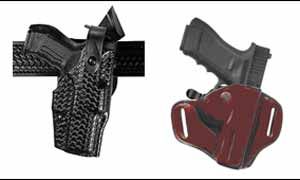By Ralph Mroz
If you are a uniformed officer who a.) carries off duty or b.) is assigned to plain-clothes details at times, then you’ll need to 1.) get a set of appropriate concealment holsters, mag carriers and light carriers (at a minimum) and 2.) practice with theses new devices. Your duty gun is/was probably carried in a full-size holster in a location that’s probably set lower than a concealment holster will be, was carried usually without a concealing garment, and had one to several retention devices that you had to manipulate in order to draw the gun. Your concealment holster will be different probably in all three respects, hence the need to practice.
It will be tempting to go with an open-top concealment holster for plain-clothes and concealed carry, and this has more-or-less been the advice of many gun trainers for the last 20 years. But there are two reasons that you should also consider a security concealment holster, instead. Reason one: there’s been an increased appreciation over the last few years that even though you’re carrying a gun, you may still spend time rolling around on the ground with a suspect, fighting him with a high degree of intensity, and you neither want your gun to pop out of its holster nor for it to be snatched by your assailant. Reason two: just because your gun may be concealed most of the time doesn’t mean that it will be all of the time. There are many times you’ll be walking around members of the general public, numbers of detainees, or crowds that are (potentially) hostile to you with your gun in its concealment holster and no concealment garment. It just happens. For those reasons, a security device on your concealment holster is a very good idea.
In fact, a form of a concealment “security” holster was the most used kind of concealment holster for a long time: remember the simple thumb-break holster that used to be so popular? These thumb-break holsters were popular because users genuinely wanted some level of security…and also because open top holsters hadn’t yet matured enough to have the right friction fit without being custom made. Thumb-break holsters are still not a bad choice to provide some security.
But technology moves on. Today we have perhaps a couple dozen different security mechanisms available on both duty and concealment holsters, consisting of various snaps, levers, springs and assorted gizmos. Every major holster manufacturer makes their version and there is almost certainly one that will appeal to you. A good piece of advice is that a security mechanism on your concealment holster is going to be more reliable and familiar for you if it’s the same kind that is (or was) on your duty holster, with which you have so many years of practice. Several manufacturers now make concealment holsters with the same kind (if not the same number) of security devices on them as is on their duty holsters. Here’s a look at a few.
 Bianchi’s DutyLok duty holster and CarryLok concealment holster. |
Bianchi’s DutyLok™ duty holster has two release mechanisms: a “knuckle break” which is released with a straight downward motion of the thumb, and a FingerLok™ release which is released with the middle finger. This system is clearly compatible with Bianchi’s concealment holsters using the same middle finger release, such as the CarryLok.
Safariland’s extensive line of duty holsters offer three security devices (not all three available on every model): the SLS rotating hood, the ALS ejection port lock that’s released by a spring-loaded thumb-lever, and the Sentry, a non-spring-loaded thumb device. Safariland also offers concealment holsters with the ALS alone, in both belt-loop style and paddle style. Another high-security Safariland model is the classic 070, known to old-timers as the SSIII. It incorporates a thumb and middle finger break, and requires a rearward rock to release the gun. The concealment version of the 070 is the 0701. It’s optimized for belt carry and has the same release mechanisms minus the thumb break
DeSantis’ concealment security holster, the Chek-Mate™ uses a thumb release lever on the inside of the holster. The locking mechanism that it releases also automatically locks the gun in the holster upon re-holstering. The DeSantis Check-mate Duty Holster uses the same mechanism coupled with a passive thumb break to provide two secure locking mechanisms.
Blackhawk’s intuitive and high security SERPA holsters are available in concealed carry, duty and tactical configurations. The duty versions include two, what I compliment by calling “thoughtless” security devices, because they require absolutely no manipulation or movement of your hand other than its normal, natural drawstroke: a thumb release and a trigger finger release. The conceal carry versions of the SERPA units employ only the trigger finger release, but are still very secure.
Strong Holster has been making their Piece-Keeper security concealment holster since way before they were popular, and it’s still a favorite among many. It employs a traditional thumb break with a thumb component that must be rotated so that the snap can be dis-engaged. Strong’s Piece-Keeper Duty Holster uses the same mechanism, except in a duty configuration.







